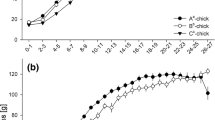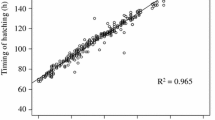Abstract
In unpredictable environments, any tactic that enables avian parents to adjust brood size and, thus, energy expenditure to environmental conditions should be favoured. Hatching asynchrony (HA), which occurs whenever incubation commences before clutch completion, may comprise such a tactic. For instance, the sibling rivalry hypothesis states that the hierarchy among chicks, concomitant to HA, should both facilitate the adjustment of brood size to environmental conditions and reduce several components of sibling competition as compared to synchronous hatching, at both brood and individual levels. We thus predicted that brood aggression, begging and feeding rates should decrease and that older chick superiority should increase with HA increasing, leading to higher growth and survival rates. Accordingly, we investigated the effects of an experimental upward and downward manipulation of HA magnitude on behaviour, growth and survival of black-legged kittiwake (Rissa tridactyla) chicks. In line with the sibling rivalry hypothesis, synchronous hatching increased aggression and tended to increase feeding rates by parents at the brood level. Begging rates, however, increased with HA contrary to our expectations. At the individual level, as HA magnitude increased, the younger chick was attacked and begged proportionally more often, experienced a slower growth and a higher mortality than its sibling. Overall, the occurrence of energetic costs triggered by synchronous hatching both for parents and chicks, together with the lower growth rate and increased mortality of the younger chick in highly asynchronous broods suggest that natural HA magnitude may be optimal.





Similar content being viewed by others
References
Altmann J (1974) Observational study of behavior: sampling methods. Behaviour 49:3–4
Anderson DJ (1989) The role of hatching asynchrony in siblicidal brood reduction of two booby species. Behav Ecol Sociobiol 25:363–368
Barrett RT, Runde OJ (1980) Growth and survival of nestling kittiwakes Rissa tridactyla in Norway. Ornis Scand 11:228–235
Bates D, Maechler M, Bolker BM (2011) package “lme4”: linear mixed-effects models using S4 classes (version 0.999375-42). http://cran.r-project.org/web/packages/lme4/index.html
Benowitz-Fredericks ZM, Kitaysky AS, Welcker J, Hatch SA (2013) Effects of food availability on yolk androgen deposition in the black-legged kittiwake (Rissa tridactyla), a seabird with facultative brood reduction. PLoS ONE 8:e62949
Blanchard P, Hanuise N, Dano S, Weimerskirch H (2007) Offspring sex ratio in relation to parental structural size and body condition in the long-lived wandering albatross (Diomedea exulans). Behav Ecol Sociobiol 61:767–773
Box G, Cox D (1964) An analysis of transformations. J R Stat Soc B Met 26:211–252
Braun BM, Hunt GLJ (1983) Brood reduction in black-legged kittiwakes. Auk 100:469–476
Drent RH, Daan S (1980) The prudent parent: energetic adjustments in avian breeding. Ardea 68:225–252
Drummond H (2006) Dominance in vertebrate broods and litters. Q Rev Biol 81:3–32
Drummond H, Gonzalez E, Osorno JL (1986) Parent–offspring cooperation in the blue-footed boody (Sula nebouxii): social roles in infanticial brood reduction. Behav Ecol Sociobiol 19:365–372
Drummond H, Rodriguez C, Schwabl H (2008) Do mothers regulate facultative and obligate siblicide by differentially provisioning eggs with hormones? J Avian Biol 39:139–143
Forbes LS (1991) Hunger and food allocation among nestlings of facultatively siblicidal ospreys. Behav Ecol Sociobiol 29:189–195
Forbes S (2011) Social rank governs the effective environment of siblings. Biol Lett 7:346–348
Forbes S, Glassey B (2000) Asymmetric sibling rivalry and nestling growth in red-winged blackbirds (Agelaius phoeniceus). Behav Ecol Sociobiol 48:413–417
Forbes S, Thornton S, Glassey B, Forbes M, Buckley NJ (1997) Why parent birds play favourites. Nature 390:351–352
Fujioka M (1985) Sibling competition and siblicide in asynchronously-hatching broods of the cattle egret Bubulcus ibis. Anim Behav 33:1228–1242
Gilby AJ, Mainwaring MC, Griffith SC (2011) The adaptive benefit of hatching asynchrony in wild zebra finches. Anim Behav 82:479–484
Gill VA, Hatch SA (2002) Components of productivity in black-legged kittiwakes Rissa tridactyla: response to supplemental feeding. J Avian Biol 33:113–126
Gill VA, Hatch SA, Lanctot R (2002) Sensitivity of breeding parameters to food supply in black-legged kittiwakes Rissa tridactyla. Ibis 144:268–283
Godfray HCJ (1995) Signaling of need between parents and young: parent-offspring conflict and sibling rivalry. Am Nat 146:1–24
Hahn DC (1981) Asynchronous hatching in the laughing gull: cutting losses and reducing rivalry. Anim Behav 29:421–427
Hamilton WD (1964) The genetical evolution of social behaviour. I. J Theor Biol 7:1–16
Hatch SA, Robertson GJ, Baird HP (2009) Black-legged kittiwake (Rissa tridactyla). The birds of North America online. Cornell Laboratory of Ornithology, Ithaca, NY
Hussell DJ (1972) Factors affecting clutch size in arctic passerines. Ecol Monogr 42:317–364
Irons DB (1992) Aspects of foraging behavior and reproductive biology of the black-legged kittiwake. University of California, Irvine
Lack D (1947) The significance of clutch-size. Ibis 89:302–352
Lack D (1954) The natural regulation of animal numbers. Oxford University Press, Oxford
Leclaire S, Helfenstein F, Degeorges A, Wagner RH, Danchin É (2010) Family size and sex-specific parental effort in black-legged kittiwakes. Behaviour 147:13–14
Leclaire S, Bourret V, Wagner RH, Hatch SA, Helfenstein F, Chastel O, Danchin É (2011) Behavioral and physiological responses to male handicap in chick-rearing black-legged kittiwakes. Behav Ecol 22:1156–1165
Magrath RD (1990) Hatching asynchrony in altricial birds. Biol Rev 65:587–622
Mainwaring MC, Blount JD, Hartley IR (2012) Hatching asynchrony can have long-term consequences for offspring fitness in zebra finches under captive conditions. Biol J Linn Soc 106:430–438
Maynard-Smith J (1982) Evolution and the theory of games. Cambridge University Press, Cambridge
Maynard-Smith J, Parker GA (1976) The logic of asymmetric contests. Anim Behav 24:159–175
Merkling T, Leclaire S, Danchin E, Lhuillier E, Wagner RH, White J, Hatch SA, Blanchard P (2012) Food availability and offspring sex in a monogamous seabird: insights from an experimental approach. Behav Ecol 23:751–758
Mock DW (1994) Brood reduction: narrow sense, broad sense. J Avian Biol 25:3–7
Mock DW, Forbes LS (1994) Life-history consequences of avian brood reduction. Auk 111:115–123
Mock DW, Parker GA (1997) The evolution of sibling rivalry. Oxford University Press, Oxford
Mock DW, Ploger BJ (1987) Parental manipulation of optimal hatch asynchrony in cattle egrets: an experimental study. Anim Behav 35:150–160
Mock DW, Schwagmeyer PL (1990) The peak load reduction hypothesis for avian hatching asynchrony. Evol Ecol 4:249–260
Müller MS, Roelofs Y, Erikstad KE, Groothuis TG (2012) Maternal androgens increase sibling aggression, dominance, and competitive ability in the siblicidal black-legged kittiwake (Rissa tridactyla). PloS ONE 7:e47763
Nathan A, Legge S, Cockburn A (2001) Nestling aggression in broods of a siblicidal kingfisher, the laughing kookaburra. Behav Ecol 12:716–725
Noguera JC, Morales J, Pérez C, Velando A (2010) On the oxidative cost of begging: antioxidants enhance vocalizations in gull chicks. Behav Ecol 21:479–484
Osorno JL, Drummond H (1995) The function of hatching asynchrony in the blue-footed booby. Behav Ecol Sociobiol 37:265–273
Ostreiher R, Pruett-Jones S, Heifetz A (2012) Asymmetric contests at the nest. Behav Ecol Sociobiol 66:1237–1246
Parker GA, Royle NJ, Hartley IR (2002) Begging scrambles with unequal chicks: interactions between need and competitive ability. Ecol Lett 5:206–215
Podlas KA, Richner H (2013) The adaptive function of hatching asynchrony: an experimental study in great tits. Anim Behav 86:567–576
R Development Core Team (2012) R: a language and environment for statistical computing. R Foundation for Statistical Computing, Vienna
Ricklefs RE (1965) Brood reduction in the curve-billed thrasher. Condor 67:505–510
Roulin A, Dreiss AN (2012) Sibling competition and cooperation over parental care. In: Royle NJ, Smiseth PT, Kölliker M (eds) The evolution of parental care. Oxford University Press, Oxford, pp 133–149
Royle NJ, Hamer KC (1998) Hatching asynchrony and sibling size hierarchies in gulls: effects on parental investment decisions, brood reduction and reproductive success. J Avian Biol 29:266–272
Schwabl H (1997) A hormonal mechanism for parental favouritism. Nature 386:231
Siegel RB, Weathers WW, Beissinger SR (1999) Hatching asynchrony reduces the duration, not the magnitude, of peak load in breeding green-rumped parrotlets (Forpus passerinus). Behav Ecol Sociobiol 45:444–450
Smiseth PT, Morgan K (2009) Asynchronous hatching in burying beetles: a test of the peak load reduction hypothesis. Anim Behav 77:519–524
Stearns S (1992) The evolution of life histories. Oxford University Press, Oxford
Stenning MJ (1996) Hatching asynchrony, brood reduction and other rapidly reproducing hypotheses. Trends Ecol Evol 11:243–246
Therneau T (2012) coxme: mixed effects Cox models. R package version 2.2-3. http://cran.r-project.org/web/packages/coxme/index.html
Vallarino A, Evans N, Daunt F, Wanless S, Nager R (2012) Egg components vary independently of each other in the facultative siblicidal black-legged Kittiwake Rissa tridactyla. J Ornithol:1–11
Venables WN, Ripley BD (2002) Modern applied statistics with S. Springer, New York
Viñuela J (1999) Sibling aggression, hatching asynchrony, and nestling mortality in the black kite (Milvus migrans). Behav Ecol Sociobiol 45:33–45
Viñuela J (2000) Opposing selective pressures on hatching asynchrony: egg viability, brood reduction, and nestling growth. Behav Ecol Sociobiol 48:333–343
White J, Leclaire S, Kriloff M, Mulard H, Hatch SA, Danchin E (2010) Sustained increase in food supplies reduces broodmate aggression in black-legged kittiwakes. Anim Behav 79:1095–1100
Wiebe KL, Bortolotti GR (1994a) Food supply and hatching spans of birds: energy constraints or facultative manipulation. Ecology 75:813–823
Wiebe KL, Bortolotti GR (1994b) Energetic efficiency of reproduction: the benefits of asynchronous hatching for American kestrels. J Anim Ecol:551–560
Wiebe KL, Bortolotti GR (2000) Parental interference in sibling aggression in birds: what should we look for? Ecoscience 7:1–9
Wiehn J, Ilmonen P, Korpimäki E, Pahkala M, Wiebe KL (2000) Hatching asynchrony in the Eurasian kestrel Falco tinnunculus: an experimental test of the brood reduction hypothesis. J Anim Ecol 69:85–95
Williams GC (1966) Natural selection, the costs of reproduction, and a refinement of Lack's principle. Am Nat 100:687–690
Acknowledgments
We thank J.-B. Ferdy and F. Helfenstein for their statistical advice. We also thank J. White, an anonymous referee, and the associate editor Ian Hartley for their critical comments on earlier versions of the manuscript. The study was financed within a 4-year grant from the French Polar Institute Paul-Emile Victor (IPEV ‘Programme 1162 SexCoMonArc’). This work originated in the lab EDB, part of the ‘Laboratoire d'Excellence’ (LABEX) entitled TULIP (ANR-10-LABX-41).
Ethical standards
This experiment was conducted under the approval of the USGS Alaska Science Center Animal Care and Use Committee, the IPEV Ethical Committee, in accordance with U.S. laws and under permits from the U.S. Fish and Wildlife Service and the State of Alaska. Any use of trade names is for descriptive purposes only and does not imply endorsement of the U.S. Government.
Author information
Authors and Affiliations
Corresponding author
Additional information
Communicated by I. R. Hartley
Rights and permissions
About this article
Cite this article
Merkling, T., Agdere, L., Albert, E. et al. Is natural hatching asynchrony optimal? An experimental investigation of sibling competition patterns in a facultatively siblicidal seabird. Behav Ecol Sociobiol 68, 309–319 (2014). https://doi.org/10.1007/s00265-013-1646-y
Received:
Revised:
Accepted:
Published:
Issue Date:
DOI: https://doi.org/10.1007/s00265-013-1646-y




